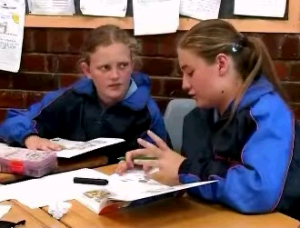Teaching Metacognition
Thinking for reading, writing and learning
Good Readers are Metacognitive
 To become lifelong learners, school going children need direct instruction on how to learn from reading. Comprehending text does not automatically follow mastery of the alphabet and phonetic code. It comes from the reader’s ability to think. Children need to discover how they make meaning from text and how their thoughts interact with the author’s words. It is through this personal interaction that they construct meaning from what they read and this in turn enables them to learn from reading.
To become lifelong learners, school going children need direct instruction on how to learn from reading. Comprehending text does not automatically follow mastery of the alphabet and phonetic code. It comes from the reader’s ability to think. Children need to discover how they make meaning from text and how their thoughts interact with the author’s words. It is through this personal interaction that they construct meaning from what they read and this in turn enables them to learn from reading.
Often learners do not know what cognitive processes they need to use in order to comprehend what they read. This is what we need to teach. We need to teach the Thinking Strategies that good readers use to understand text. As educators our primary goal is to help learners become better thinkers and thus become better readers, writers and learners.
Good readers practice strategic reading behaviours
In addition to metacognitive awareness, learners also need to know what thinking behaviours they can perform and when to perform them so that they can help themselves better comprehend and enjoy what they read. These strategic reading behaviours include being able to
- activate prior knowledge before, during and after reading
- decide what is important in a text
- synthesise information
- draw inferences during and after reading
- ask questions
- self-monitor the accuracy and effectiveness of their thinking
- know when they understand and when they don’t
- repair faulty comprehension.
 Each of these reading behaviours can be explicitly taught. As educators, our goal needs to be to develop strategic reading behaviours so that learners know when and how to apply these different cognitive processes, and to perform them at greater and greater complexity. As their textbooks become more and more complex to read, so too must learners’ skills to read and learn from such texts. This means that all teaches need to be reading teachers throughout the school years. How else can we hope to develop self-directed lifelong learners who know how to learn from reading?
Each of these reading behaviours can be explicitly taught. As educators, our goal needs to be to develop strategic reading behaviours so that learners know when and how to apply these different cognitive processes, and to perform them at greater and greater complexity. As their textbooks become more and more complex to read, so too must learners’ skills to read and learn from such texts. This means that all teaches need to be reading teachers throughout the school years. How else can we hope to develop self-directed lifelong learners who know how to learn from reading?
A Curriculum for Metacognition: What to teach and how to teach it
Thinking Powers for Reading Comprehension
MetaGroup Communications has developed a curriculum for teaching thinking. This curriculum is presented in our latest offering: a teacher training DVD that presents both the substance and the methods of teaching five key thinking powers that learners use for reading, writing and learning. This curriculum translates brain-based research into classroom practice and demonstrates how to teach strategically. See how educators can design and implement lessons that use:
- The MetaGroup Planner for Strategic Teaching which incorporates:
- Schema Theory as a framework for teaching reading comprehension,
- Co-operative Learning Lesson Sequence to develop intrinsic motivation,
- Co-operative Learning groupwork tasks designed with Multiple Intelligences.
This curriculum has been captured in live classroom lessons on our professional development DVD entitled: Thinking Powers for Reading Comprehension: How to Integrate Reading into Learning Area Teaching
- Click here to view the promotional clip of what is on the DVD: Thinking Powers for Reading Comprehension: How to Integrate Reading into Learning Area Teaching
- Click here to view Reading Process animation
- Click here to find out how to bring the Thinking Powers and best teaching practice into your classroom under Professional Development Courses & Workshops


